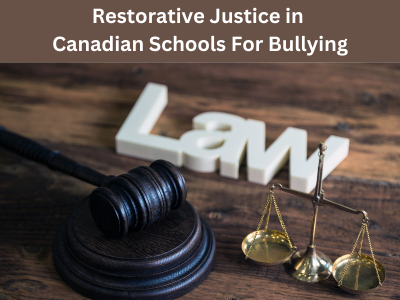Bullying in schools across Canada is a serious concern that affects countless students every year. The psychological and emotional toll it takes on young minds is undeniable. However, there is a promising approach gaining traction in Canadian schools that seeks to address this issue in a constructive way – Restorative Justice. In this blog, we will explore how restorative justice is making a difference in Canadian schools regarding combating bullying and promoting a safer, more inclusive learning environment.
Understanding the Bullying Epidemic in Canadian Schools:

Bullying in schools in Canada remains a pressing issue. The Canadian Institute of Health Information reports that as of my last knowledge update in September 2021, 1 in 3 adolescent students reported being bullied at least once in the past month. These statistics are concerning, and they highlight the urgent need for effective solutions.
The Role of Restorative Justice:
Restorative Justice is a philosophy and approach that focuses on repairing harm caused by wrongdoing, rather than simply punishing the wrongdoer. In the context of bullying in schools, it aims to:
1. Hold Offenders Accountable: Restorative Justice allows those who engage in bullying to understand the consequences of their actions and take responsibility for the harm they’ve caused.
2. Empower Victims: It provides victims with a safe platform to express their feelings and needs, fostering a sense of empowerment and healing.
Rebuild the Community: Restorative Justice involves the entire school community, fostering a sense of collective responsibility and promoting a culture of empathy and respect.
Restorative Justice in Canadian Schools:
Canadian schools are increasingly adopting Restorative Justice practices as part of their approach to dealing with bullying. These practices often include:
1. Restorative Circles: These are structured meetings where students, including the victim and the offender, come together to discuss the incident. Trained facilitators guide the conversation, ensuring that it remains productive and respectful.
2. Peer Mediation Programs: Some schools implement peer mediation programs, where trained students mediate conflicts between their peers, including bullying incidents.
3. Workshops and Training: Teachers and staff receive training on Restorative Justice principles and how to implement them effectively in their schools.
4. Community Building Activities: Schools incorporate activities that strengthen the sense of community and belonging among students, reducing the likelihood of bullying.
Benefits of Restorative Justice
The application of Restorative Justice in Canadian schools has shown several promising benefits:
1. Reduced Recidivism: Studies indicate that Restorative Justice can lead to lower reoffending rates among bullies, as they gain empathy and understanding of the harm they’ve caused.
2. Improved School Climate: Schools that embrace Restorative Justice often report improved relationships, reduced conflicts, and a more positive overall atmosphere.
3. Empowered Students: Victims of bullying feel heard and validated, which can lead to improved mental well-being and a sense of agency.
4. Community Engagement: Restorative Justice involves parents, teachers, and students creating a more inclusive and safer school environment.
Bullying in schools in Canada is a complex issue, but Restorative Justice offers a promising approach to address it. By focusing on accountability, empathy, and community-building, this method aims to create lasting change. As schools across Canada continue to adopt Restorative Justice practices, there is hope that we can create a future where every student feels safe and respected in their educational journey.
Contact Rogerson Law Group at 416-504-2259 for expert legal assistance in addressing bullying in Canadian schools. Our experienced team is dedicated to helping you navigate the legal aspects of bullying cases to ensure a safer educational environment for all students. Don’t hesitate to reach out; we’re here to support you.


